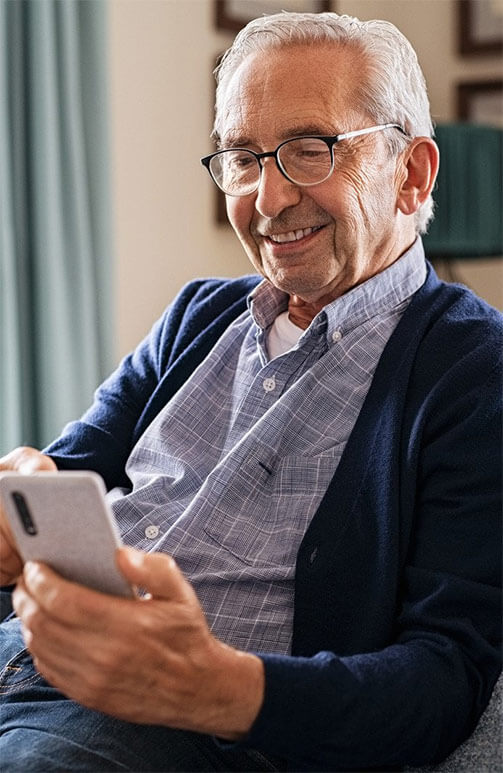Reverse Mortgage Australia
The Ultimate Guide To Eligibility & Lender Comparison


FREE Reverse Mortgage Australia guide from Seniors First. 30,000+ downloads since its first edition in 2008.
Discover how to compare Reverse Mortgages in Australia beyond just interest rates. Learn about the 'hidden' lender policies and post-settlement procedures, and why the guidance of a specialist Reverse Mortgage Broker is recommended.
A Reverse Mortgage is a special type of loan available to Australian homeowners over 55 years of age. If you are eligible, you can release a certain percentage of your home equity for cash. You can use the money for renovation, travel, a new car, debt consolidation, living expenses or for any worthwhile purpose.
Many Australian retirees love Reverse Mortgages because they can access the money they need without the need to sell the property. Plus, monthly repayments are not required (the debt is repaid when you sell the property or when the last surviving borrower passes away).
It’s a powerful financial product for Australian seniors, especially those who are “asset rich, but cash poor”.
Modern Reverse Mortgages have come a long way. Interest is only calculated on the drawn portion of the loan, while you enjoy 100 per cent of the ongoing capital growth in your property
Before you make a decision, it’s good to first learn how Reverse Mortgages work. When you are ready to apply, the next step is comparing providers to find the right lender for your needs. This is the hard part.
To help you understand the differences, Seniors First created this definitive guide.
In this page, we will help you identify the things to consider when comparing Reverse Mortgages in Australia. Some factors are publicly available, while most data points are not.
150+ Points Of Difference Between Top 4 Lenders:
Why Reverse Mortgage Comparison Is Hard
Reverse Mortgages in Australia are very complex and it’s difficult to compare providers. While Reverse Mortgage lenders publish basic product information, there are 150+ points of difference between the top 4 lenders, with many important factors 'hidden'.
FACT: The top four Reverse Mortgage lenders approved to be on the Seniors First panel have over 150 points of difference across three areas: 1) Product Features 2)Eligibility criteria and credit policies, and 3)Post-settlement loan procedures.
For example, two lenders may offer you the same interest rate and loanable amount, but one may have an extra layer of assessment on home renovations or on helping your kids finance their first home. Other lenders may reject applications based on your age, post code or land size. Sadly, some lenders may not even advise the reason why your application was rejected.
Therefore, doing the shopping on your own can be overwhelming. The full eligibility criteria and credit policies of the lenders is not published on any website, nor on comparison sites. The internal processes of lenders are industry “secrets” that are only fully known to specialist brokers like Seniors First who work with them day in, and day out.


EXPERT TIP: Finding a suitable Reverse Mortgage lender is not just about comparing interest rates. It’s also about understanding their loan eligibility criteria and credit policies so your application can be approved.
1. Reverse Mortgage Loan Product Features
Most lenders in Australia publish some aspects of their Reverse Mortgage loan offers. Here's a sample of product features that lenders make publicly available to compare:
Feature
What It Means
2. Reverse Mortgage Eligibility Criteria & 'Hidden' Lender Credit Policies
Here's a limited sample list of 'hidden' credit policies that may impact your eligibility for a Reverse Mortgage loan:
Credit Policy
What It Means
Lender credit policies are the “hidden rules” that can affect your eligibility for a Reverse Mortgage loan.
They are not published by lenders but are nevertheless central to how long your application will take, and whether or not your loan application will be approved, or declined.
There are dozens more of these policy areas, and each lender’s loan approval criteria is often different from the others.
Without industry knowledge to guide your choices, you may waste a lot of time and energy submitting multiple applications and talking to different lenders only to be rejected.


KEY INSIGHT: Seniors First proprietary data indicates the average length of time borrowers hold a Reverse Mortgage in Australia is about 7.5 years. However these loans don’t have any maximum term, so it’s possible some individuals may have a loan for 10, 20, or even 30 years. In such cases the lender becomes a long-term retirement funding partner, making their post-settlement loan procedures a defining factor in the lived experience of the borrower.
3. Post-settlement Loan Procedures
The day-to-day borrower experience provided by lenders who offer Reverse Mortgages in Australia is also effectively 'hidden' until your loan settles. Ongoing flexibility and future access to funds differ widely.
There are four (4) key areas where post-settlement loan procedures vary between Reverse Mortgage banks:
Seniors First has been helping Australians access Reverse Mortgage finance for 20 years. We know the detailed history of lenders, and how reliably they pass on Reserve Bank (RBA) interest rate cuts to borrowers.
For example, one lender has consistently followed the Reserve Bank for 15 rate adjustments in a row. Another lender has increased their rates above and beyond the Reserve Bank increases. Alternatively, one lender didn't pass on the full rate increases in the past.
No one can predict the future, but it helps to know how lenders have behaved in the past. The current interest rate of any lender is just their price, at a moment in time. Whether a Reverse Mortgage lender is consistently inclined to pass on future RBA rate cuts, or use them as an opportunity to increase their net interest margin (NIM), is perhaps the most influential factor on the long-term cost of a loan.
It’s not uncommon for Reverse Mortgage borrowers to sometimes require additional funds after the original loan has settled. Circumstances change, and new funding needs can arise. In these cases, it’s possible to get what’s called a ‘Top up’ loan from your Reverse Mortgage lender.
Although all top ups qualify as a new credit application, the processes vary with each lender. Some have easier, more automated processes whilst others apply a stricter criteria that can make getting access to additional funds a long, difficult process.
Many Reverse Mortgage borrowers like to make voluntary payments into the loan, in order to minimise the interest cost. However, depending on the Reverse Mortgage loan product there may be restrictions around your ability to ‘redraw’ these funds back out of the loan at a later date.
Example: let’s say you received a windfall and decided to pay $30,000 back into the loan, so you can reduce the compounding interest. Then after a few years, you need the money again for medical expenses. Is it possible to request a redraw of the funds without paying a fee? Will the process be quick and easy, or long and painful? Will you need to switch products, or even refinance to a different lender altogether?
Not all loan products offer simple, unlimited redraw facilities.
A pre-approved line of credit, or ‘cash reserve’, is a very popular Reverse Mortgage product feature. Let’s say you are approved for a total loan of $200,000 loan, but you only want to draw $100,000 initially. The rest of the available funds can sit in a cash reserve, where they won’t attract any interest until you draw down on the funds in future - and then only on the amounts you draw.
Can you access this facility anytime through phone or online banking? Or will the lender require you to submit additional documents or assess your property before releasing the reserves? Some lenders may delay access or impose strict conditions, while some offer easy access.
These post-settlement procedures can have a material impact on the quality of life you enjoy in retirement. A bad experience with a Reverse Mortgage bank or lender can lead to frustration, delays and stress. This can be especially difficult for older borrowers in their 80’s or 90’s who might be dealing with chronic health conditions, or those who struggle with technology and additional paperwork.
While some lenders are proactive, user-friendly, and flexible, others are strict, slow, or paper-based. The whole experience can affect your ability to access the loan proceeds in your retirement years.
Specialist brokers such as Seniors First deal with these internal systems on a daily basis. We help you navigate the 150+ points of difference and advise on the lenders most suited to your needs based on product, eligibility, and long-term usability requirements.

Why It’s Best To Use A Specialist Reverse Mortgage Broker
Seniors First is the most experienced specialist Australian broker group when it comes to Reverse Mortgages. We started in 2006, and we’ve successfully helped thousands of Australian seniors release home equity safely:
Getting a good deal and saving money is important, but it’s not just about comparing interest rates and fees. There are many dozens of “hidden” procedures and lender policies that may affect whether you’re eligible, how much you can borrow, and how easy you can access your money later on.
Only a specialist broker such as Seniors First has deep, first-hand experience of the internal processes and credit criteria of Reverse Mortgage lenders. This information is not publicly available. It’s also highly dynamic; each lender regularly applies changes to their policies and procedures. The Seniors First team is one of the few brokers in Australia who can reliably assess which lender is most likely to fund a loan based on property type, location, loan purpose, spending patterns and more.


KEY INSIGHT: According to a Seniors First customer survey, 62 percent of Reverse Mortgage borrowers rate ‘speed to funding’ as ‘important’ or ‘very important’. If fast access to cash is needed, a specialist broker can advise which lenders to avoid.

There are also compelling reasons to use a specialist Reverse Mortgage broker, over a ‘generalist’ mortgage broker who rarely does Reverse Mortgage transactions. Specialist brokers typically have a unique set of skills and expertise that the average mortgage broker is unlikely to possess:
“A specialist Reverse Mortgage Broker like Seniors First is best-placed to deliver you the perfect equity release outcome, with minimum fuss."
Benefits of using a specialist broker for Reverse Mortgages in Australia
Taking The Next Steps
If you’re considering a Reverse Mortgage, the first step is to understand your situation. There is no rush to start an application just yet. Gather all the information you need so you can confidently plan your next actions.
You may start with a DOWNLOAD of our free guidebook that outlines all the basic information you need before talking to a broker, including the ten "Reverse Mortgage Secrets".
If you are just curious whether you may qualify, try our quick ELIGIBILITY check - it will only take you a few minutes.
Call us on 1300 745 745 or send an email.

Rated 4.9 stars on
“Sincere thanks to Andrew and Seniors First .. the loan has been life changing.”
Deborah Collett
You were professional and knowledgeable in all our dealings and kept us in the picture at every stage of the process to ensure a smooth Reverse Mortgage journey.
You also clearly communicated all the options available on Reverse Mortgages so we could make fully informed decisions.
Most importantly, you quickly responded to and answered all our questions ( and there were many ! )
We strongly recommend Angela at Seniors First to all potential clients.
nothing was too much trouble
Her high level of professionalism and empathetic manner was always reassuring and for that we were fortunate to have her as our broker
Adam walked us through each step of the process with ease, and we never felt alone at anytime. His recommendations were professional and unbiased and we didn’t hesitate to listen to his advice. I don’t know of any other bank or financial institution that would take the time and so much care, to ensure that their clients were happy. We certainly are, we can’t recommend Adam Oakley at Seniors First enough. It was a very big, life changing decision we had to consider and we feel grateful to have found Adam to see it through with us. Once again, thank you Adam for your time and patience. We couldn’t be happier. You are a true professional.
Between Seniors First and my Broker Adam Oakley they made the whole application from start to finish a breeze.
The Professionalism and Guidance I got from Adam to make sure I understood everything before he advised on the right product that best suited me.
I would highly recommend Seniors First and Adam to anyone interested in a Reverse Mortgage.
I had an outstanding experience working with Seema at Seniors First. She was professional, patient, and incredibly knowledgeable, guiding me through every step of the process with care and understanding. Seema made what could have been a stressful experience feel smooth and straightforward. Her communication was excellent, and she always took the time to explain things clearly. I truly appreciate her kindness and dedication — highly recommend Seema and Seniors First for anyone looking for honest and supportive financial advice.
You have given me outstanding service, guidance and help. You made clear to me the advantages, disadvantages and outcomes of a Reverse Mortgage.
You reassured me about the right timing and steps to take in the whole process.
I couldn't be more grateful and very satisfied knowing that my home loan is paid and I have enough to live comfortably.
I felt extremely comfortable working through the process. There was no pressure to continue but I am extremely glad I decided to proceed.
Seniors First were very considerate and concerned that I completely understood the pros and cons of the decision I was making. I felt at ease discussing the very involved process through very friendly and supportive phone conversations and via many emails. I greatly appreciated how I was kept up to date with the applications progress. Contact about any concerns was always welcome.
I unreservedly recommend their thorough unquestionable service. I am amazed at how smooth the process was, especially as it resulted in a very positive outcome.
Thank you for your friendly, unbelievable guidance and support.
Frequently asked questions
It’s worth noting that the major Australian banks—Commonwealth Bank, Bankwest, NAB, ANZ, St George and Westpac—no longer offer Reverse Mortgages. Although they continue to service existing customers, for various reasons they have all stopped providing any new loans. Most of these institutions exited the market over the past decade, which has left a gap now filled by niche and specialist providers.
There are currently only about 7 to 8 small banks and non-bank lenders who are actively offering new Reverse Mortgage loans in the Australian market. Seniors First, the leading specialist Reverse Mortgage broker, provides access to the top four lenders who between them fund in excess of 95 per cent of new loans.
When choosing a Reverse Mortgage lender, it’s important to do due diligence on the provider (or rely on a broker to do this for you). The lenders approved to be on the Seniors First panel have all been scruitnized for product features, fees, customer service, and fair loan contract terms that align with our values.
When thinking about releasing home equity via a Reverse Mortgage it pays to consider the future impact of the loan on three key aspects of your life:
- Lifestyle
- State of mind
- Financial
The impact on lifestyle is almost always positive. Access to extra cash for living, and to fund the things you’ve been waiting for such as holidays, renovations, or a new car invariably improves retirement lifestyle.
However with some lenders you must stay in the home, and there are restrictions on how long you can be away or even if you can rent out the property. This may limit your lifestyle options, especially if you intend to travel extensively or use the home for AirBnB income. And if you move out—such as transitioning into aged care or moving in with family—the loan typically becomes repayable within 12 months. This can place pressure on your finances or force the sale of your home.
The impact of a Reverse Mortgage on state of mind is also usually positive, as access to more cash typically reduces financial stress. This is especially so in cases where the loan funds are used for debt consolidation, or to pay overdue council rates or strata levies.
It’s common for potential borrowers to have some doubts at the start of the process, but these are usually resolved as a better understanding emerges of how Reverse Mortgage in Australia really works. Information and education is key. However, in some cases people who are predisposed to high anxiety may not be suited to a Reverse Mortgage. Unless such a borrower is able to reconcile concerns about potential downsides, and get comfortable with the decision, then for state of mind it may be best not to proceed.
One of the primary financial downsides of a Reverse Mortgage is that, unless you make regular voluntary repayments, interest will compound. Over the long term this can potentially cause the amount you owe to grow substantially (especially if the borrower draws a large lump sum at a young age). However, a specialist broker can often mitigate this by advising on a good loan structure that draws the funds gradually over time in order to preserve more equity.
Another downside is that a Reverse Mortgage will reduce home equity. As the loan balance increases, equity held in the security property typically decreases (although this may be offset by a subsequent rise in the capital value of the home). This can significantly reduce the value of a borrower’s estate and the inheritance left for family, although some lenders offer a ‘protected equity’ feature that can limit the effects of this.
However there is no risk of negative equity (where you owe more than the value of the home) because all lenders are mandated by law to offer a No Negative Equity Guarantee.
A Reverse Mortgage can also limit future financial options. If a large portion of the home’s value is released, it may be harder to access other loans or refinance later should financial needs or circumstances change.
Borrowers must also understand that the property must be maintained. You are required to keep the home in good repair and ensure it remains insured. If these basic responsibilities aren’t met, it could be considered a breach of the loan terms, potentially triggering early repayment requirements.
The costs and fees associated with establishing Reverse Mortgages is also a downside. These can include setup fees, ongoing service or account fees, legal fees, and discharge fees. Collectively, these expenses may eat into the usable funds you receive from the loan (if you don’t have enough cash already to cover them).
Another risk is that, in rare cases, the Reverse Mortgage may affect Age Pension eligibility. If you take the funds as a lump sum and invest, gift or loan the money then Centrelink could reduce or eliminate your Age Pension entitlements. This risk can easily be mitigated by checking with Centrelink first.
Reverse Mortgages are not suitable for short-term needs. They’re designed for people who plan to stay in their home long-term. If you sell the home soon after taking out the loan, the costs involved may outweigh the benefits received.
Lastly, Reverse Mortgages can have an impact on estate planning. Family members might not be aware of, or may not agree with, your decision to take out a Reverse Mortgage. This can lead to confusion or disputes after you pass away, particularly if the home must be sold to repay the loan. However with good planning, legal advice, and clear documentation this downside can also be mimimised.
For a full list of pros and cons see this article.Yes, you can make voluntary payments on a Reverse Mortgage in Australia—but you are not required to. Most Australian Reverse Mortgage products allow borrowers to make voluntary payments at any time. These payments can include:
- Interest payments – to stop or slow the growth of the loan balance.
- Partial principal repayments – to reduce the outstanding balance.
- Full repayments – if you decide to pay off the loan early.
There are no penalties for early repayment with most lenders, but it may be more difficult to redraw the voluntary payments back out again at a later date with some lenders. It's wise to consult with a specialist broker, or check your loan contract for any conditions.
In addition, some lenders have alternative Reverse Mortgage products that offer a lower interest rate for a program of regular repayments on the loan. These product variations can be a good option for borrowers who are still working, or those with the financial means to service the monthly interest.
The Home Equity Access Scheme (HEAS) is the Australian Government’s version of a Reverse Mortgage. It allows older Australians to unlock some of the equity in their home to receive regular fortnightly payments, helping to supplement their income in retirement. This scheme is administered by Services Australia and is available to people of Age Pension age—whether they receive a full pension, part pension, or even if they don’t currently qualify for any pension but meet the age and residency rules.
HEAS is designed to provide a safe and steady income stream, not a significant lump sum. Borrowers can nominate how much they wish to receive each fortnight (up to 150% of the maximum Age Pension), and the payments are made directly into their bank account. Interest is charged at a government-set rate and is compounded, meaning the loan balance grows over time. However, repayments are completely voluntary—the loan is generally repaid when the home is sold or from the estate after death.
Importantly, the HEAS includes a No Negative Equity Guarantee, ensuring that neither the borrower nor their estate will owe more than the value of the home, even if the loan balance exceeds it over time. Since the HEAS is not assessed under the regular asset and income tests for the Age Pension, it typically does not affect Age Pension eligibility.
While both the HEAS and standard Reverse Mortgages serve the purpose of releasing home equity without needing to sell the property, there are some important differences.
A Reverse Mortgage is offered by private lenders or banks, generally to homeowners aged 55 or over. Which means younger borrowers can access Reverse Mortgages, compared with the HEAS. These loans are more flexible in terms of how the money is accessed—you can usually choose a lump sum, a regular income stream, a line of credit, or a combination of these. This makes them suitable for people who need a large upfront payment, for example, to pay off debts, fund home renovations, or cover major health expenses.
In contrast, the HEAS provides regular fortnightly payments and limited lump sum. This makes it better suited to people with simple needs, who just want to top up their regular income in retirement without borrowing a large amount all at once.
Another key difference is the interest rate. The government’s HEAS charges a lower interest rate, whereas standard Reverse Mortgages have market-based interest rates that are usually higher, depending on the lender. Like HEAS, commercially available Reverse Mortgages also feature compounding interest and require no repayments until the home is sold or the borrower passes away. Both options include a No Negative Equity Guarantee, as required by Australian law.
However, Reverse Mortgages can impact Age Pension entitlements in some rare cases. The HEAS does not trigger this issue because payments are treated differently under social security rules.
In terms of fees and costs, the HEAS is minimal or even fee-free in many cases, while bank Reverse Mortgages often come with establishment fees, legal fees, valuation costs, and ongoing service fees—which can erode the amount of usable equity.
Lastly, with a commercial Reverse Mortgage, the loan size can be larger, depending on your age and property value, giving more financial flexibility. HEAS, on the other hand, is capped at 150% of the Age Pension.
If you're seeking low-risk, regular top-ups to your pension without affecting your Age Pension entitlements, the HEAS is an excellent option. It’s government-backed, cost-effective, and provides peace of mind with a No Negative Equity Guarantee.
If you want to release equity at a younger age, need a lump sum, greater flexibility, or want to borrow larger amounts, a Reverse Mortgage may be more suitable—but you’ll need to consider higher costs, possible pension impacts, and more complexity.
For a more detailed breakdown on the comparison read this article



